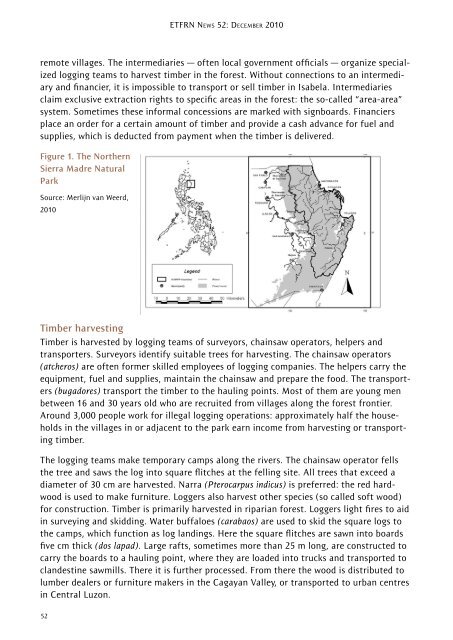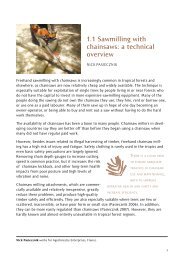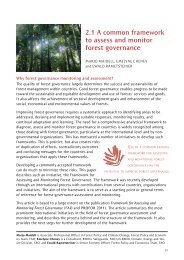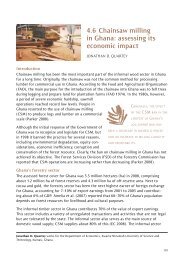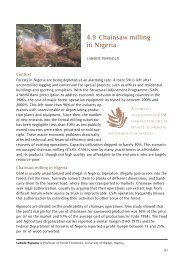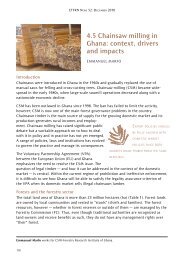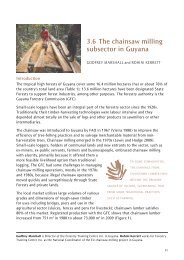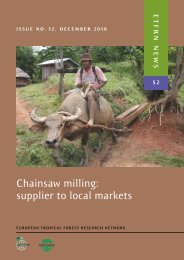Chainsaw milling: supplier to local markets - European Tropical ...
Chainsaw milling: supplier to local markets - European Tropical ...
Chainsaw milling: supplier to local markets - European Tropical ...
You also want an ePaper? Increase the reach of your titles
YUMPU automatically turns print PDFs into web optimized ePapers that Google loves.
52<br />
ETFRN NEws 52: DEcEmbER 2010<br />
remote villages. The intermediaries — often <strong>local</strong> government officials — organize specialized<br />
logging teams <strong>to</strong> harvest timber in the forest. without connections <strong>to</strong> an intermediary<br />
and financier, it is impossible <strong>to</strong> transport or sell timber in isabela. intermediaries<br />
claim exclusive extraction rights <strong>to</strong> specific areas in the forest: the so-called “area-area”<br />
system. sometimes these informal concessions are marked with signboards. Financiers<br />
place an order for a certain amount of timber and provide a cash advance for fuel and<br />
supplies, which is deducted from payment when the timber is delivered.<br />
Figure 1. The Northern<br />
sierra Madre Natural<br />
park<br />
source: merlijn van weerd,<br />
2010<br />
Timber harvesting<br />
Timber is harvested by logging teams of surveyors, chainsaw opera<strong>to</strong>rs, helpers and<br />
transporters. surveyors identify suitable trees for harvesting. The chainsaw opera<strong>to</strong>rs<br />
(atcheros) are often former skilled employees of logging companies. The helpers carry the<br />
equipment, fuel and supplies, maintain the chainsaw and prepare the food. The transporters<br />
(bugadores) transport the timber <strong>to</strong> the hauling points. most of them are young men<br />
between 16 and 30 years old who are recruited from villages along the forest frontier.<br />
around 3,000 people work for illegal logging operations: approximately half the households<br />
in the villages in or adjacent <strong>to</strong> the park earn income from harvesting or transporting<br />
timber.<br />
The logging teams make temporary camps along the rivers. The chainsaw opera<strong>to</strong>r fells<br />
the tree and saws the log in<strong>to</strong> square flitches at the felling site. all trees that exceed a<br />
diameter of 30 cm are harvested. narra (Pterocarpus indicus) is preferred: the red hardwood<br />
is used <strong>to</strong> make furniture. loggers also harvest other species (so called soft wood)<br />
for construction. Timber is primarily harvested in riparian forest. loggers light fires <strong>to</strong> aid<br />
in surveying and skidding. water buffaloes (carabaos) are used <strong>to</strong> skid the square logs <strong>to</strong><br />
the camps, which function as log landings. here the square flitches are sawn in<strong>to</strong> boards<br />
five cm thick (dos lapad). large rafts, sometimes more than 25 m long, are constructed <strong>to</strong><br />
carry the boards <strong>to</strong> a hauling point, where they are loaded in<strong>to</strong> trucks and transported <strong>to</strong><br />
clandestine sawmills. There it is further processed. From there the wood is distributed <strong>to</strong><br />
lumber dealers or furniture makers in the Cagayan Valley, or transported <strong>to</strong> urban centres<br />
in Central luzon.


